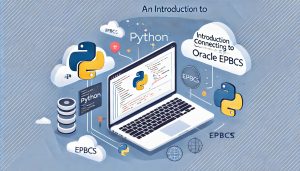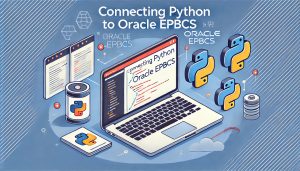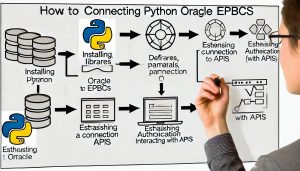Introduction: python code to connect to epbcs

Connecting to Oracle Enterprise Planning and Budgeting Cloud Service (EPBCS) via Python can significantly enhance the efficiency of your financial planning and analysis processes. This guide provides a detailed, step-by-step approach to establishing a secure and robust connection between your Python application and Oracle EPBCS.
Prerequisites
Before we delve into the connection process, ensure you have the following prerequisites:
- Oracle EPBCS credentials (username, password, service URL).
- Python installed on your local machine (preferably version 3.6 or higher).
- Necessary Python libraries (requests, pandas, json, etc.).
Step-by-Step Guide to Connecting Python to EPBCS

Step 1: Install Required Python Libraries
First, ensure that you have the necessary libraries installed. You can install them using pip:
bash code
pip install requests pandas json
Step 2: Define Connection Parameters
Next, define the connection parameters such as the service URL, username, and password. It’s best to store these parameters securely, for example, using environment variables.
python code
import os
EPBCS_URL = os.getenv(‘EPBCS_URL’)
USERNAME = os.getenv(‘EPBCS_USERNAME’)
PASSWORD = os.getenv(‘EPBCS_PASSWORD’)
Step 3: Establishing a Connection
To establish a connection, we use the requests library to handle HTTP requests. The basic structure involves sending a GET request to the EPBCS REST API endpoint.
python code
import requests
from requests.auth import HTTPBasicAuth
def connect_to_epbcs():
url = f”{EPBCS_URL}/HyperionPlanning/rest/v3/applications/”
response = requests.get(url, auth=HTTPBasicAuth(USERNAME, PASSWORD))
if response.status_code == 200:
return response.json()
else:
response.raise_for_status()
# Example usage
data = connect_to_epbcs()
print(data)
Step 4: Handling Authentication
Oracle EPBCS uses Basic Authentication. Ensure your credentials are correctly encoded. For enhanced security, consider using OAuth tokens if supported by your EPBCS instance.
Step 5: Interacting with EPBCS APIs
EPBCS offers various endpoints for different operations such as data retrieval, metadata management, and job execution. Below is an example of how to retrieve application metadata.
Retrieving Application Metadata
python code
def get_application_metadata():
url = f”{EPBCS_URL}/HyperionPlanning/rest/v3/applications/YourAppName”
response = requests.get(url, auth=HTTPBasicAuth(USERNAME, PASSWORD))
if response.status_code == 200:
return response.json()
else:
response.raise_for_status()
# Example usage
metadata = get_application_metadata()
print(metadata)
Step 6: Error Handling and Logging
Implement robust error handling and logging to track issues effectively. Use Python’s logging module for this purpose.
python code
import logging
logging.basicConfig(level=logging.INFO)
def connect_to_epbcs():
url = f”{EPBCS_URL}/HyperionPlanning/rest/v3/applications/”
try:
response = requests.get(url, auth=HTTPBasicAuth(USERNAME, PASSWORD))
response.raise_for_status()
logging.info(“Connection successful”)
return response.json()
except requests.exceptions.HTTPError as err:
logging.error(f”HTTP error occurred: {err}”)
except Exception as err:
logging.error(f”Other error occurred: {err}”)
# Example usage
data = connect_to_epbcs()
if data:
print(data)
Conclusion: python code to connect to epbcs
Connecting Python to Oracle EPBCS can streamline your financial data processes and enhance the efficiency of your planning and budgeting activities. By following the steps outlined in this guide, you can establish a secure connection and leverage the power of Python to interact with EPBCS seamlessly.
Frequently Asked Questions: python code to connect to epbcs
Why should I connect to EPBCS using Python?
Answer: Connecting to EPBCS using Python allows for data retrieval and management tasks automation, integration with other systems, and the ability to leverage Python’s powerful data processing libraries to enhance financial planning and analysis processes.
What libraries do I need to connect Python to EPBCS?
Answer: The primary libraries required are requests for handling HTTP requests, pandas for data manipulation, and json for parsing JSON data. These can be installed using pip.
How do I securely store my EPBCS credentials in Python?
Answer: It is recommended to store credentials in environment variables. This prevents sensitive information from being hard-coded in your script, enhancing security.
How do I handle authentication when connecting to EPBCS?
Answer: EPBCS typically uses Basic Authentication. You can use the HTTPBasicAuth class from the requests library to pass your username and password securely.
What should I do if my connection to EPBCS fails?
Answer: Implement robust error handling using Python’s logging module to capture and log errors. This helps in diagnosing issues. Ensure your credentials and URL are correct, and check for network connectivity issues.
Can I use OAuth tokens for authentication with EPBCS?
Answer: If your EPBCS instance supports OAuth tokens, it is a more secure authentication method than Basic Authentication. You must follow Oracle’s documentation for setting up and using OAuth tokens with EPBCS.
How do I retrieve application metadata from EPBCS?
Answer: You can retrieve application metadata by sending a GET request to the appropriate EPBCS REST API endpoint using the requests library. Ensure you handle the response and errors appropriately.
What are some common endpoints available in EPBCS APIs?
Answer: Common endpoints include those for retrieving application metadata, managing data forms, executing jobs, and accessing task lists. Refer to the EPBCS REST API documentation for detailed information on available endpoints.
How do I handle errors and log them in my script?
Answer: Use the logging module to log errors and other important events in your script. Implement try-except blocks to catch exceptions and log them using logging.error(). This practice helps in tracking and troubleshooting issues efficiently.
Can I integrate EPBCS with other systems using Python?
Answer: Yes, Python’s versatility allows you to integrate EPBCS with other systems and applications. You can use various APIs and libraries to facilitate data exchange and process automation between EPBCS and other platforms.
What is the benefit of using environment variables for configuration?
Answer: Using environment variables for configuration enhances security by keeping sensitive information like credentials out of your source code. It also makes it easier to manage different configurations for development, testing, and production environments.
Are there any security considerations I should be aware of?
Answer: Ensure that your connection to EPBCS uses HTTPS to encrypt data in transit. Store credentials securely using environment variables or secret management tools. Regularly update your dependencies to address any security vulnerabilities.
Conclusion

Connecting Python to Oracle Enterprise Planning and Budgeting Cloud Service (EPBCS) offers a powerful way to improve the efficiency and effectiveness of financial planning and analysis processes.
By leveraging Python’s robust libraries and its flexibility, organizations can automate data retrieval, manage metadata, and execute planning jobs with ease.
In this guide, we have covered the necessary steps to establish a secure connection to EPBCS, starting from installing required libraries to handling authentication and error management.
We’ve also provided a practical example of retrieving application metadata and emphasized the importance of secure credential management using environment variables.
Implementing a connection to EPBCS using Python facilitates streamlined financial operations and enables integration with other systems, allowing for a more cohesive and automated workflow.
Including error handling and logging ensures that any issues encountered can be effectively diagnosed and resolved, further enhancing the reliability of your financial systems.
As organizations continue to seek ways to optimize their planning and budgeting processes, the ability to connect Python to EPBCS stands out as a valuable capability. By following the comprehensive steps outlined in this guide, you can harness the full potential of Python and EPBCS, driving greater accuracy, efficiency, and collaboration in your financial planning efforts.
